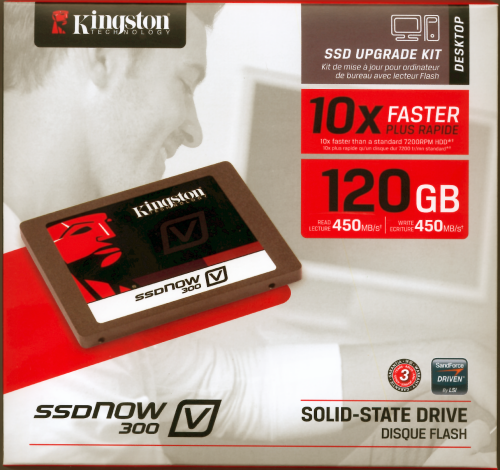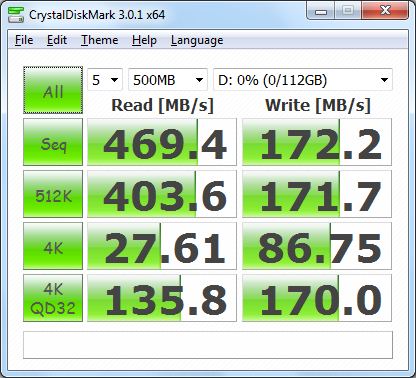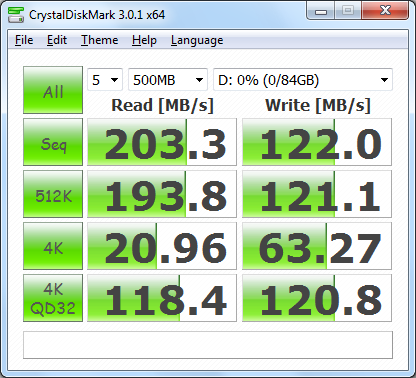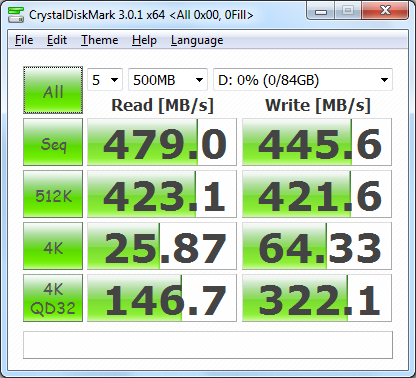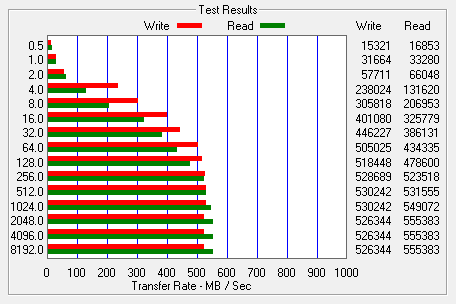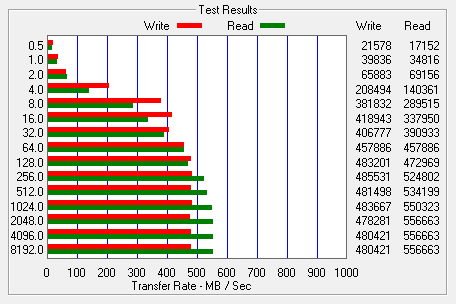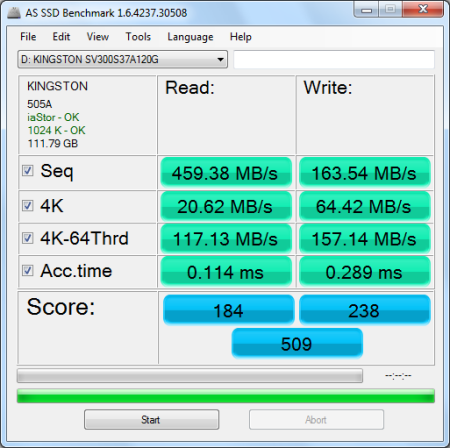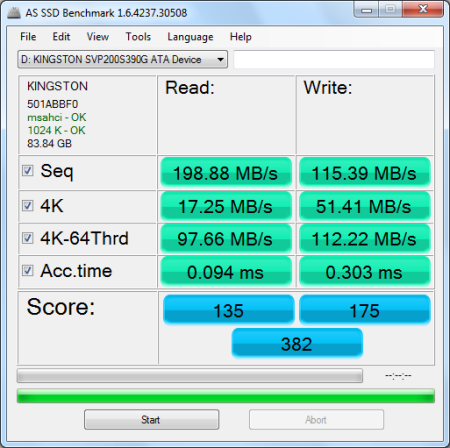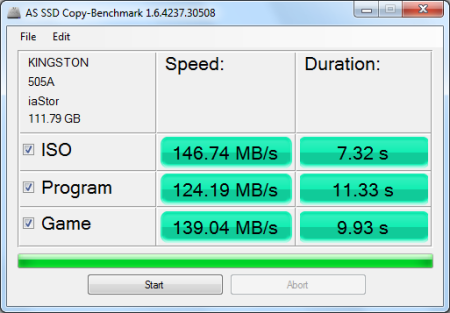

Model: Kingston SSDNow V300 120GB Solid State Drive
Manufacturer: Kingston
Provided By: Kingston
As the world’s largest independent manufacturer of memory products, Kingston Technology doesn't need much of an introduction. The company got its start in 1987, when the computer industry was suffering from a severe shortage of surface-mount memory chips. To provide a solution, Kingston's founders designed a new Single In-Line Memory Module (SIMM) that used readily available, older technology through-hole components. Today, Kingston offers more than 2,000 memory products for everything from computers, servers and printers to MP3 players, digital cameras and cell phones.

Like many other manufacturers, Kingston has set its sights on the growing solid-state drive (SSD) market. This winter, the company launched the next generation of its SSDNow V Series SSD, the V300. Designed for cost-conscious consumers looking to upgrade their existing desktop or notebook PC, the V300 is 10x faster than a 7200RPM hard-disk drive. It is powered by an LSI SandForce Flash Storage Processor (FSP) solution customized for Kingston, and optimized for industry-leading 19nm NAND flash memory to deliver sequential read and write speeds of up to 450MB/s.
The SSDNow V300 is available in 60GB, 120GB and 240GB capacities as either a stand-alone drive or as an upgrade kit containing cloning software and other accessories for a desktop and/or notebook system. For this review, Kingston sent us the 120GB desktop upgrade kit. The 120GB version of the V300 is capable of reading and writing at 450MB/s and delivering up to 85,000 random read and 55,000 random write IOPS.
| Kingston SSDNow V300 120GB Solid State Drive | |||||||||||||||||||||||||||||||||||||||||||
General Specifications
Performance
Reliability
Power Consumption
Environmental
Dimensions and Weight
Other Features
|
With store shelves already full of "SandForce Driven" SSDs with similar specs and features, the V300 is up against some stiff competition. To give you an idea of what to expect, we'll take a closer look at Kingston's new SSD and then put it through its paces to see how it performs. Does the V300 have what it takes? Can it deliver the value and performance we've come to expect from Kingston? Keep reading as we find out.
The SSDNow V300 comes in an attractive red, black and white box. Along with a picture of the drive, the front advertises many of its key features including its 120GB capacity, rated speeds, SandForce controller and three year warranty. The back of the box provides a bit more information as well as pictures of the box's contents.

The desktop upgrade kit that Kingston sent us for this review includes a number of accessories. Along with the V300 SSD you'll find a 3.5" adapter bracket with screws, SATA data and power cables, an installation video on DVD and a CD containing hard drive cloning software.
Physical Features:
While a bit heavier than other SSDs, the SSDNow V300 is very well constructed. The outer casing is made entirely out of metal and is covered by a rough, matte black finish. The top of the drive also has a large, red and black sticker advertising its capacity as well as the fact that it is part of Kingston's SSDNow V300 series.
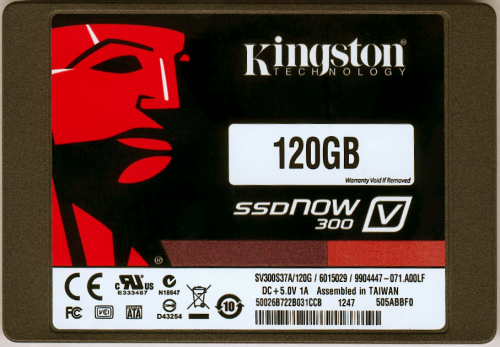
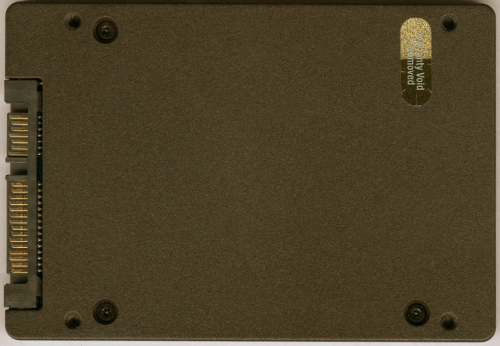
Like Kingston's V+200, KC100 and HyperX series SSDs, the V300 uses SandForce's SF-2281 controller chip. The SF-2281 can be found in a number of other SSDs including the ADATA XPG SX900, Corsair Force Series, OWC Mercury 6G, OCZ Vertex 3, Patriot Pyro SE, Silicon Power S70 and the SanDisk Extreme.
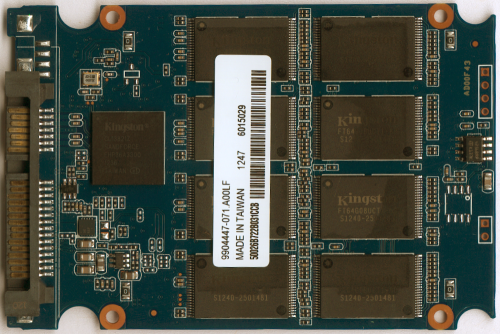

For the 120GB V300, Kingston opted to use Toshiba's 19nm 8GB MLC Toggle Mode NAND flash chips. Looking at the pictures above, you can see that there are eight of these chips on either side of the PCB. If you do the math, you'll see that this equals 128GB and not the 120GB of storage the drive advertises. The SandForce controller uses this extra 7% (8GB) to maximize read and write performance and extend the endurance and overall reliability of the drive.
The test system used in this review was an HP 8200 Elite. The computer came equipped with an Intel Core i5-2400 CPU, 4GB of DDR3 1333MHz memory, Seagate Barracuda 7200.12 ST3250312AS 250GB SATA 6 Gb/s hard drive, NVIDIA Quadro FX580 512MB PCIe graphics card and an Intel 82579-LM gigabit network card. For the operating system, I installed a fresh copy of Windows 7 Enterprise.
To test the performance of the SSDNow V300, I ran a series of benchmarks using CrystalDiskMark 3.0.1, HD Tach RW 3.0.4.0, ATTO Disk Benchmark 2.46, AS SSD, HD Tune Pro 4.61, Anvil's Storage Utilities and Iometer. For comparison, I've also included test results from the Silicon Power S70, Plextor PX-256M5P, OCZ Vertex 4, Kingston HyperX 3K, Kingston SSDNow V+200, Plextor PX-256M3P, SanDisk Extreme and Samsung 830 SSD.

As I mentioned earlier, the SSDNow V300 is based on LSI's SandForce SF-2281 controller. Like other SandForce controllers, the SF-2281 features a technology called DuraWrite, which uses data compression to lower write amplification and extend the life of the drive by reducing the number of program-erase cycles. This data compression also plays a big part in the controller's performance. The more the data can be compressed, the faster an SSD like the V300 is able to read and write. Looking at the screenshot above, you can see that there is a considerable performance difference when writing incompressible (0%) and compressible (100%) data. However, thanks to the V300's Toggle Mode NAND, its read speeds aren't affected nearly as much.
CrystalDiskMark 3.0.1:
First, I ran a few quick tests using CrystalDiskMark. This benchmark tool measures the performance of a storage device by testing its sequential read and write speeds as well as its random read and write speeds using blocks 512K and 4K in size.
According to Kingston, the 120GB SSDNow V300 is capable of reading and writing at 450MB/s when connected to a SATA 6 Gb/s port. The drive had no problems exceeding this number when reading, but came up well short of it when writing CrystalDiskMark's default (random) test data. However, with the highly compressible 0x00 (0 Fill) data, the V300 was able to read at 485.7 MB/s and write at 487.7 MB/s.
HD Tach RW 3.0.4.0:
Next, I used HD Tach to test the SSDNow V300's read, write and burst speeds as well as its seek times and CPU usage.

Looking at the screenshot above, you can see that the SSDNow V300 had average read and write speeds of 399.8 MB/s and 384.5 MB/s respectively, as well as a burst speed of 427.6 MB/s.
ATTO Disk Benchmark 2.46:
I also used ATTO Disk Benchmark to test the SSDNow V300's sequential read and write speeds. The tests are run using blocks ranging in size from 0.5KB to 8192KB and the total length set to 256MB.
When tested with ATTO, the SSDNow V300's read speeds topped out at about 555 MB/s and its write speeds at 530 MB/s. This is pretty impressive considering the drive's read and write speeds are rated at 450MB/s.
AS SSD:
AS SSD is a relatively new benchmark designed specifically for solid state drives. The application contains five synthetic tests used to determine the sequential and random read and write performance of a drive. Take note that AS SSD uses incompressible data in its tests, which can have a major impact on the scores of SandForce-based drives like the SSDNow V300.
AS SSD also includes a copy benchmark. This test copies an ISO (two large files), program (many small files) and game (small and large files), returning the speed and duration of each.
HD Tune Pro 4.61:
Next, I ran a series of tests using HD Tune Pro. This hard disk utility measures a drive's performance by testing its sequential read and write speeds as well as its access time, burst rate and CPU usage. For this review, I'm also going to use it to benchmark the SSDNow V300's random read and write speeds, random access times and the number of operations per second.
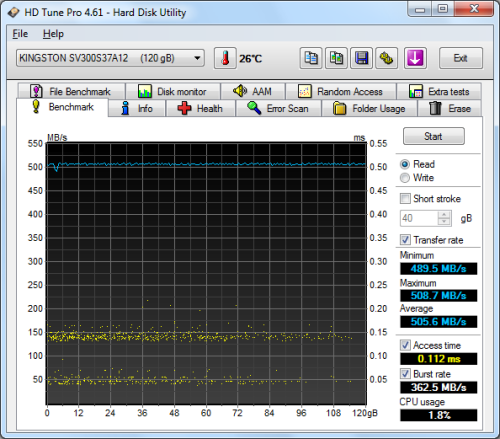 Kingston SSDNow V300 120GB - HD Tune Read Benchmark |
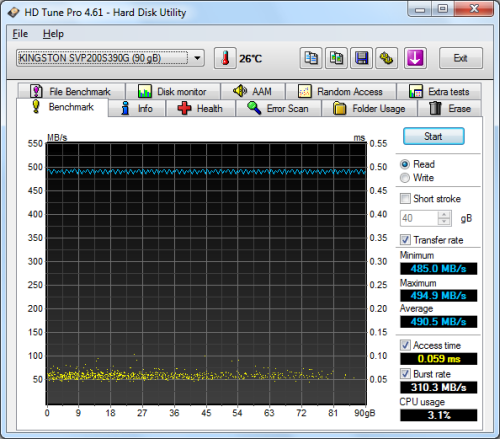 Kingston SSDNow V+200 90GB - HD Tune Read Benchmark |
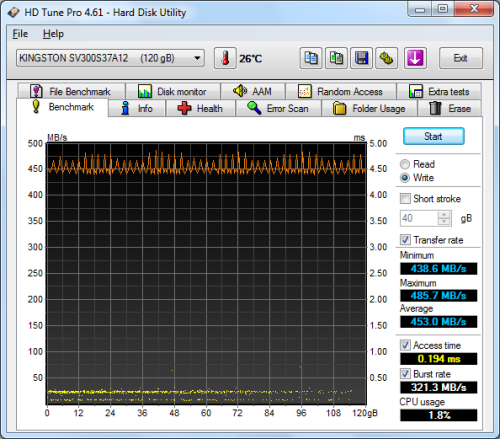 Kingston SSDNow V300 120GB - HD Tune Write Benchmark |
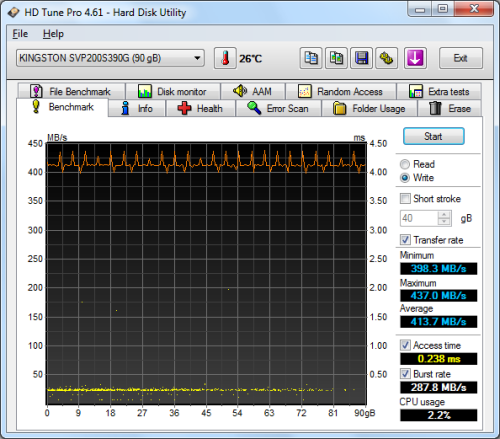 Kingston SSDNow V+200 90GB - HD Tune Write Benchmark |
The SSDNow V300 performed very well when benchmarked with HD Tune. The drive had average read and write speeds of 505.6 MB/s and 454.0 MB/s, respectively, as well as a burst rate of 362.5 MB/s when reading.
 Kingston SSDNow V300 120GB - HD Tune Random Access Read |
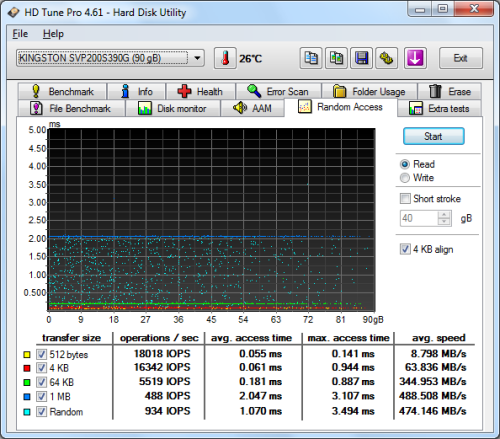 Kingston SSDNow V+200 90GB - HD Tune Random Access Read |
 Kingston SSDNow V300 120GB - HD Tune Random Access Write |
 Kingston SSDNow V+200 90GB - HD Tune Random Access Write |
The SSDNow V300 didn't disappoint when doing random reads and writes. When reading 4KB blocks, the drive reached 20,962 IOPS and had an average speed of 81.885 MB/s. The SSDNow V300 was even faster when writing, reaching 21,562 IOPS with an average speed of 84.230 MB/s.
Anvil's Storage Utilities:
Anvil's Storage Utilities is another new benchmark designed with SSDs in mind. The standard storage benchmark measures a drive's performance by testing its transfer speeds, access times and IOPS. This test was first run with incompressible data and then again with highly compressible (0-Fill) data.

Kingston SSDNow V300 120GB - Incompressible Data
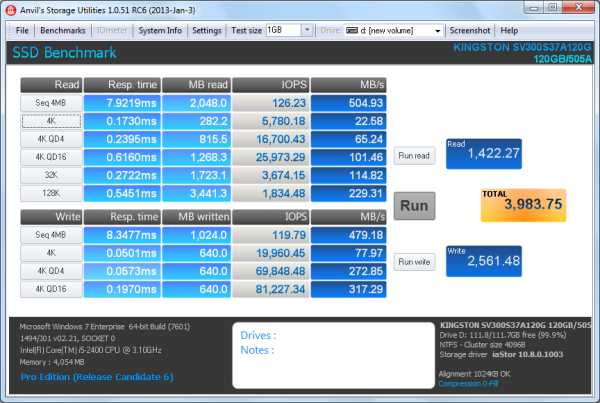
Kingston SSDNow V300 120GB - Compressible Data
Iometer:
Lastly, I ran a series of tests using Iometer. This tool can be configured to benchmark a number of things. In this case, I used it to measure the SSDNow V300's read and write speeds and the number of operations per second. The tests were run using random bytes and a queue depth of 3.

The SSDNow V300's performance was very similar to what we saw in our other tests. With highly compressible, repeating data, the drive was able to read at 529.35 MB/s and write at 506.52 MB/s. The V300 did not slow nearly as much as the V+200 when reading random data. However, its write speeds dropped to 163.76 MB/s.

The SSDNow V300 also performed very well when doing random reads and writes. With repeating data, the drive was able to read at 72.64 MB/s and write at a blazing 313.31 MB/s. Here too, the SSDNow V300 took a performance hit when tested with random data. However, it was still able to write at 156.61 MB/s.

According to Kingston, the SSDNow V300 can deliver a maximum of 55,000 IOPS when randomly writing 4K blocks. In our tests, the drive reached 80,206 IOPS with repeating data and 40,061 IOPS with random data.
TRIM Performance:
While SSDs offer many benefits, there are some downsides to using flash memory. One of the biggest issues people run into is performance degradation. Over time, an SSD will run out of fresh blocks and will have to write over data the file system has marked as deleted. This procedure is very complicated and can slow an SSD's write speeds considerably.
To address this problem, most manufacturers have added TRIM support to their SSDs. The TRIM command allows an operating system, such as Windows 7, to tell an SSD which data blocks are no longer in use. Using this information, the drive proactively erases these blocks and adds them to the free block pool.
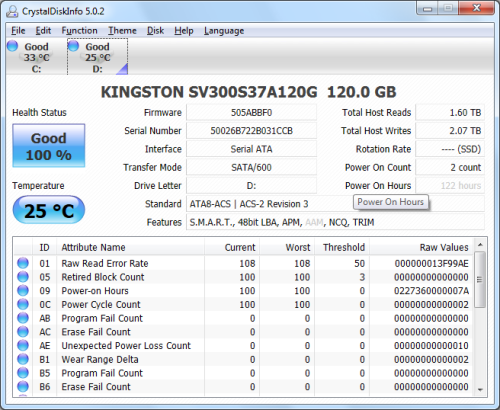
I should point out that the SSDNow V300 ships with SandForce's 5.0.5 firmware. Earlier releases of the Series 5 firmware had problems with TRIM, which are fixed in this version.
To test the V300's TRIM function, I first put the drive in a "dirty" state. I used Iometer to fill the entire drive and then ran a random write test for 20 minutes. Looking at the screenshot below, you can see that the V300's average read and write speeds dropped to 126.9 MB/s and 198.4 MB/s, respectively.
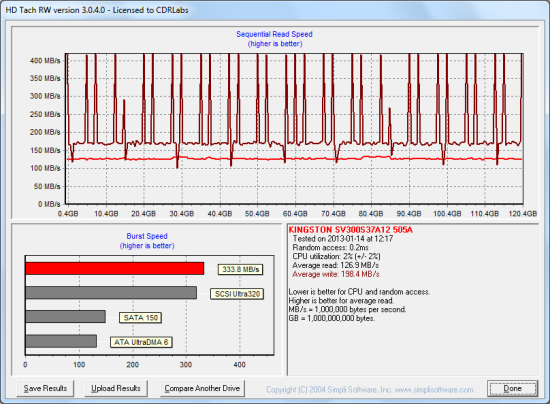
Kingston SSDNow V300 120GB - Dirty
To see how well the V300 could recover, I let the computer sit for a few hours and then reran the test. The drive's average read speed jumped back up to 307.6 MB/s. However, its write speed lagged a bit behind, averaging out at 211.6 MB/s.

Kingston SSDNow V300 120GB - After Trim
Lastly, I used an older version of OCZ's Toolbox utility (yes, it works) to perform a secure erase on the V300. With the drive wiped clean, its average write speed jumped back up to 385.8 MB/s.
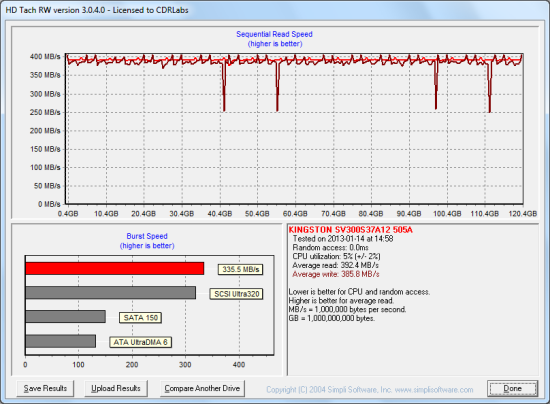
Kingston SSDNow V300 120GB - Secure Erased
Final Thoughts:
The Kingston SSDNow V300 is an excellent choice for the cost-conscious consumer looking to upgrade their existing desktop or notebook PC. This new solid state drive combines LSI's SandForce SF-2281 controller with Toshiba's 19nm MLC Toggle Mode NAND flash to deliver some surprisingly good performance. While rated at only 450 MB/s, the 120GB V300 was able to read at speeds as high as 585 MB/s and write at speeds in excess of 500 MB/s. It also exceeded expectations in our random write tests, delivering more than 80,000 IOPS at low queue depths. Impressive performance isn't the only thing the V300 has to offer either. Along with a good looking, well constructed design, the SSD is available as a standalone drive or as part of an upgrade kit containing cloning software and other accessories for a desktop and/or notebook system.
The SSDNow V300 is available in 60GB, 120GB and 240GB capacities. Prices on Amazon.com currently range from about $75 up to $242, with the 120GB desktop upgrade kit reviewed here going for about $120.

Highs:
- Available in 60GB, 120GB and 240GB capacities
- SandForce SF-2281 processor
- Toggle Mode NAND flash
- Excellent sequential read and write speeds
- SATA 6Gb/s interface
- Supports SMART, TRIM and Garbage Collection
- Available as stand-alone drive or as part of an upgrade kit
- Well constructed design
- Ultra-slim form factor
- Reasonably priced
- 3 year warranty
Lows:
- Not as fast when writing incompressible data
